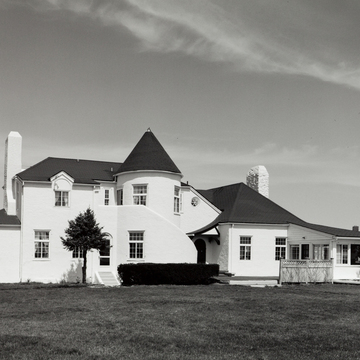Where Boston Neck Road curves in toward the beach at Narragansett Pier, a stuccoed gatehouse, featuring a stubby turret at one end of a rectangular block, is all that remains of Kenneth Murchison's original Dunes Club. Murchison, an architect best known for the Moderne Beaux-Arts Apartments in New York, which he designed with Raymond Hood, was part of the Narragansett summer scene. For the Dunes Club he concocted a sprawling stage set in creamy stucco with a variegated roof which hybridized Provençal château turrets with Spanish haciendas, splashed with patches of handwrought brick and colored decorative tile. This pretty dream was lost to the 1938 hurricane, whereupon, much to Murchison's vexation, another firm received the commission for its present replacement. This is a more severe design in a plain wooden vernacular made monumental and semimodernist. Even more extensive than the original, it boasts a grand array of leisure facilities: glass-fronted dining and ball room, decks, boardwalks, horseshoe enclaves of luxury cabanas—and reassures by appearing to be much more hurricane proof than Murchison's sandcastle. Fortunately, what may be the best of Murchison's designs for the Dunes Club complex still remains. At the northern end of the public section of the beach (and visible from it) are two houses, privately owned but built in conjunction with the club, which show his Mediterranean forms abstracted. Here Mission Revival massing of turrets and winding stairs creates cubes, cylinders, and spirals organized in sculptural compositions, with dramatic roof silhouettes pierced by two tall chimneys.
You are here
Dunes Club Gatehouse and Cottages
1928–1929, Kenneth Murchison. 1939–1940, rebuilding of club after 1938 hurricane, Purves, Cope and Stewart. 137 Boston Neck Rd.
If SAH Archipedia has been useful to you, please consider supporting it.
SAH Archipedia tells the story of the United States through its buildings, landscapes, and cities. This freely available resource empowers the public with authoritative knowledge that deepens their understanding and appreciation of the built environment. But the Society of Architectural Historians, which created SAH Archipedia with University of Virginia Press, needs your support to maintain the high-caliber research, writing, photography, cartography, editing, design, and programming that make SAH Archipedia a trusted online resource available to all who value the history of place, heritage tourism, and learning.

